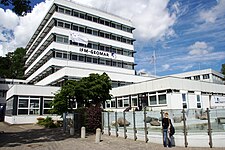The GEOMAR - Helmholtz Centre for Ocean Research Kiel (GEOMAR), formerly known as the Leibniz Institute of Marine Sciences (German: Leibniz-Institut für Meereswissenschaften, IFM-GEOMAR), is a research institute in Kiel, Germany. It was formed in 2004 by merging the Institute for Marine Science (Institut für Meereskunde Kiel, (IFM)) with the Research Center for Marine Geosciences (GEOMAR) and is co-funded by both federal and provincial governments.[4] It was a member of the Leibniz Association until 2012 and is coordinator of the FishBase Consortium.[2] Since 2012 it is member of the Helmholtz Association and named GEOMAR - Helmholtz Centre for Ocean Research Kiel. The institute operates worldwide in all ocean basins,[4] specialising in climate dynamics, marine ecology and biogeochemistry, and ocean floor dynamics and circulation.[5] GEOMAR offers degree courses in affiliation with the University of Kiel,[3] and operates the Kiel Aquarium[6] and the Lithothek, a repository for split sediment core samples.[7]
 | |
| Abbreviation | GEOMAR |
|---|---|
| Formation | 2012 |
| Type | Nonprofit research organization |
| Purpose | Marine research |
| Headquarters | Kiel, Germany |
Region served | Worldwide |
Membership | Helmholtz Association Deutsches Forschungsbohrkonsortium[1] FishBase Consortium[2] |
Director | Katja Matthes |
| Affiliations | University of Kiel[3] |
Budget | € 72 million[4] |
Staff | about 950 (scientists plus supporting staff) |
| Website | geomar.de |

GEOMAR is structured into four research divisions:[8]
GEOMAR operates two open ocean research vessels: the 36-year-old RV Poseidon (1050 GT)[14] and the 20-year-old RV Alkor (1000 GT).[15] In 2009, both vessels were refurbished and modernised.[16] It also operates the research cutter, RC Littorina (168 GT)[17] and the research boat, RB Polarfuchs (16 GT).[18] In addition it operates JAGO, a three-ton research submersible, the only manned research submersible in Germany,[4][19][20] capable of diving to 400 metres,[21] as well as a remotely operated underwater vehicle, ROV KIEL 6000 capable of diving to 6,000 metres,[22]anautonomous underwater vehicle, AUV ABYSS,[23] and a video-controlled hydraulic grab, TV-Grab.[24] At the end of 2010, the institute took possession of ROV PHOCA, a new 1.5 ton ROV with an operational working depth of 3000 metres.[25]